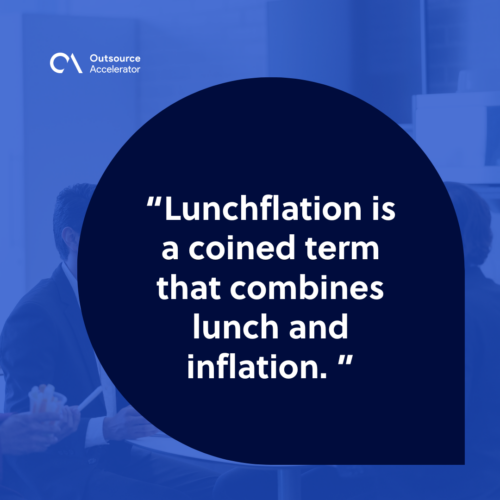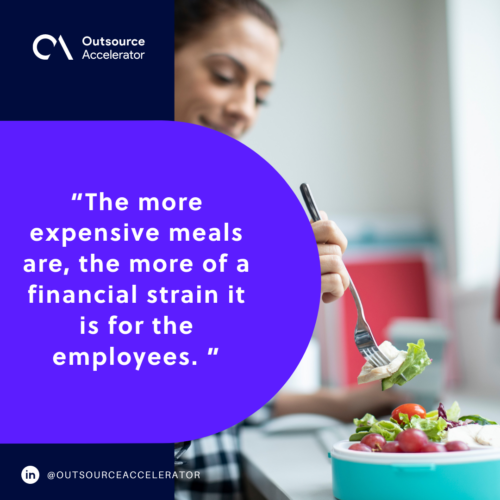Understanding lunchflation and its impact on employees

Inflation has been increasing over the past few years, especially over the pandemic.
A report from Visual Capitalist revealed that the United States has reached an inflation rate of 7.7% in 2022.
No one likes an increase in prices for necessities, especially food. This affects everyone everywhere, even in the office. This phenomenon is called lunchflation, and it is a growing concern that on-site employees are currently facing.
This article looks into this issue and its effects on employees.
What is lunchflation?
Lunchflation is a coined term that combines lunch and inflation. It refers to the increase in food prices, specifically lunch meals, making it a burden to have lunch at work.
Because of these increased prices, employees have to rethink and re-budget their allowances in order to buy food and still have enough for other necessities.
Not only that, but industries such as restaurants and groceries have to deal with decreased demand due to a spike in prices.

Inflation in the food industry
Inflation has been the leading cause of lunchflation. All markets and sectors are affected, and food is no exception.
A study from the Economic Research Service reported several price spikes in 2022:
- Food prices increased by 9.9%
- Food-at-home prices increased by 11.4%
- Food-away-from-home prices increased by 7.7%
Fortunately, the same report found that prices slowed down in 2023, and increases were slightly less than those of 2022, thanks to the deceleration of supply chain issues.
However, that is not to say the lunchflation issue is solved:
- Food prices increased by 5.8%
- Food at-home prices increased by 5.0%
- Food-away-from-home prices increased by 7.1%
Effects of lunchflation on employees
For some, meals getting a little more expensive does not seem like that grand of an issue, but it is a significant burden for those who work on-site and must order their lunch everyday.
Here are some ways it can negatively affect employees.
Financial strain
Lunch meals are a daily expense that adds up over time. The more expensive meals are, the more of a financial strain it is for the employees.
Over time, the employees’ finances significantly decrease, which hinders personal saving goals, short-term purchases, and even long-term investments.

Decreased productivity
When employees do not eat enough for lunch, it can affect their overall disposition and how they do their work.
Feelings of hunger and inability to focus because of it can significantly decrease productivity. Employees may function less than normal, and the quality of their work may be diminished.
Mood swings
Having a hearty meal can have a positive impact on one’s attitude. However, naturally, the opposite can happen as well.
Not being able to eat a substantial meal can affect one’s mood. People may feel more irritable or experience mood swings when they do not get the necessary energy and nutrients.
Reduced office appearances
When employees go to the office, their main expense for the day is lunch. However, lunchflation has made going back to the office more expensive, which may lead to fewer employees showing up.
Employees may not see the value of eating in the office with colleagues because they do not want to spend too much on a pricey lunch.
How to address lunchflation
Inflation is something that normal employees cannot really control, so the best plan of action is to adapt and come up with new ways to deal with expensive food prices.
Here are a few ways to address lunchflation:
Meal planning and budgeting
A good way to prepare for expensive meals is to budget your finances carefully. Assess how much you would be willing to spend on food per day while taking into account additional allowance for other things.
If you decide to eat at or order from a pricey restaurant, take that into consideration and increase your allowance accordingly.
It is ultimately a matter of careful decision-making about what to eat and how much to spend.
Budget-friendly restaurants
Some restaurants are more affordable than others while still offering substantial meals. It is worth considering other budget-friendly options when looking for a place to eat.
This is true if you have a go-to restaurant where you eat lunch regularly. If you notice that this restaurant contributes to your financial strain, it is best to look elsewhere.
You can even discover new food options as a bonus.
Home meal preparation
Cooking at home is another cost-effective alternative to mitigate the effects of lunchflation.
By preparing meals from scratch, individuals can save money by using ingredients found in their household. They can even exercise greater control over portion sizes.

Navigating through lunchflation in the workplace
At the end of the day, employees still have to eat, but lunchflation makes ordering meals a real hassle.
Lunchflation is definitely taking a toll on employees. Despite its adverse effects, it is a manageable issue that requires careful financial planning and consideration for alternative solutions.







 Independent
Independent




